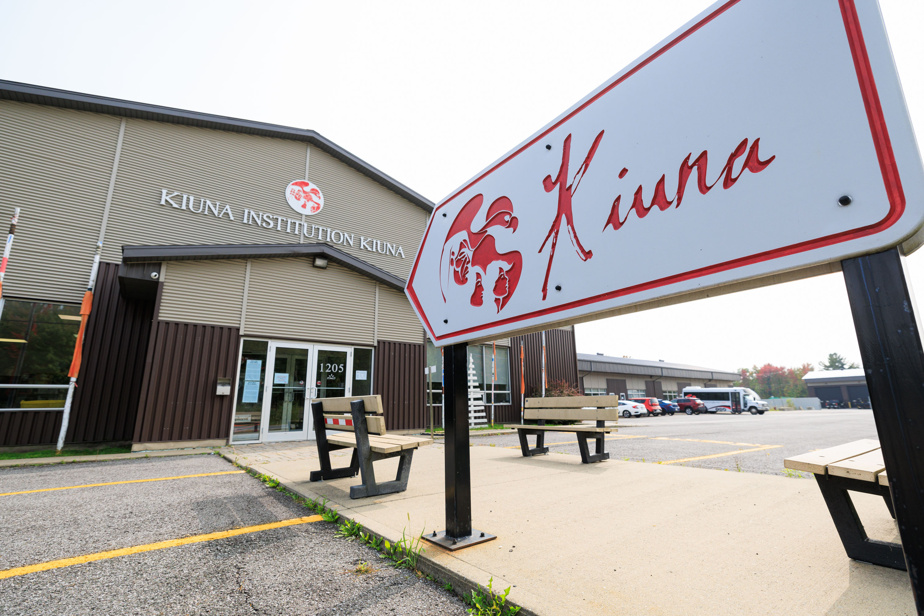The only indigenous post-secondary establishment in Quebec, Cégep Kiuna opened a branch in Wemotaci, in Mauricie, as a pilot project last year. The experiment is confirmed – and tried elsewhere – this year.
“We want to facilitate access to education for young people from isolated communities,” explains Prudence Hannis, general director of Kiuna, a CEGEP in Odanak, in Centre-du-Québec. Kiuna is a term that means “Ours” in Abenaki. “It’s easier to study staying in their community. »

PHOTO HUGO-SÉBASTIEN AUBERT, THE PRESS
Prudence Hannis, Managing Director of Kiuna
Around fifteen students completed certificates in Indigenous education at Wemotaci last year – and there will be the same number this year. “It’s really going to change things for us,” said Wemotaci council member Miguel Kookoo. “There are great training needs. Our young people will be able to have a professional life here, stay close to their families and their culture. » In addition to the education cohort, one CEGEP student completes a certificate in administration and another completes a complete college program (DEC).
Véronique Pittikwi, the school mobilization agent for Wemotaci’s class, notes that most of the students – all women at the moment – are young mothers. “They can come home and feed their children for lunch. They have almost the same schedule as them. Afterwards, they will be able to work at the daycare. »
A satellite class was also opened this year in Alma, at the Mamik Center, which serves the indigenous community of Lac-Saint-Jean. “There were students who could not leave the region, often for family reasons,” says M.me Pittikwi. So, we opened a class for this year. I don’t know if she will come back next year. »
Kiuna CEGEP has been significant in the careers of several Indigenous people, including Miguel Kookoo, from Wemotaci. “I trained in water treatment and worked for five years,” he says. My girlfriend, who is Anishnabe, decided to do addiction training at Kiuna. I followed her the following year. It gave me back the taste for studying. My courses on the history of indigenous claims and treaties led me to a baccalaureate in law at the University of Sherbrooke. I returned to Wemotaci when I was elected councilor. I assist the vice-chief on these matters. »

PHOTO HUGO-SÉBASTIEN AUBERT, THE PRESS
Kiuna CEGEP has been significant in the careers of many Indigenous people.
Heir to Manitou College
“In the 1970s, there was Manitou College in the Laurentians, but it only lasted a few years,” observes Prudence Hannis. Before the opening of Kiuna CEGEP, “there had been a desire to rebuild an indigenous post-secondary establishment in Quebec for almost 20 years”.
Manitou College opened in 1973 on a former military base used for missile testing, which is now the La Macaza federal penitentiary. Struggling with chronic deficits, Manitou closed its doors at the end of 1976. In all, it trained around a hundred students, in English and French.
Founded in 2011, Kiuna is in the process of training the indigenous leaders of tomorrow, precisely like Manitou College, believes Emmanuelle Dufour, anthropologist at the University of Montreal.
“Ghislain Picard and Lise Bastien, among others, studied at Manitou,” says Mme From the oven. Mr. Picard has been chief of the Assembly of First Nations Quebec-Labrador since 1992. Mr.me Bastien headed the First Nations Education Council (FNCE) for a long time.
At Manitou College, “there were certainly management problems,” says M.me Bastien. It was a leitmotif of Indian Affairs, but we never specified what the management problems were. One thing is certain, the government did not want a hotbed of indigenous activism in Quebec.”
According to Mme Dufour, the final blow was Ottawa’s decision to allocate funds from Manitou College to the different communities. “We told them: ‘If you want to continue financing Manitou, it’s your decision,’” says M.me From the oven.

PHOTO TAKEN FROM JACQUES WATSO’S FACEBOOK PAGE
Jacques Watso
Towards technical training?
For 12 years, Kiuna has transformed Odanak, according to Jacques Watso, member of the Abenaki Council of Odanak. “It allowed us to build links with all the communities. And obviously, it allows young people to stay on site, to have the necessary training for the jobs that exist here. » Future electric battery factories, planned not far from Odanak, make Mr. Watso imagine technical training.
I saw young people leaving Kiuna grown up, with greater pride in their identity.
Lisa Bastien
She herself arrived “on the go” at Manitou, at 18, after dropping out of high school. “Similar to Kiuna, even though Manitou only lasted four years, it made a big difference to a lot of people. »

PHOTO HUGO-SÉBASTIEN AUBERT, THE PRESS
For 12 years, Kiuna has transformed Odanak, according to Jacques Watso, member of the Abenaki Council of Odanak.
Indigenous settlements in Western Canada
In Western Canada, Indigenous post-secondary institutions appeared shortly after Manitou and never closed, according to Sheila Carr-Stewart, of the University of Alberta, who published the collection in 2020 Knowing the Past, Facing the Future on indigenous education.
“That means we see a lot of Indigenous professors in universities in the Prairies and British Columbia,” says M.me Carr Stewart.
The gap in attendance at post-secondary institutions between Indigenous and non-Indigenous people is, however, lower in Eastern Canada than in the Prairies and British Columbia, according to a Statistics Canada study published in June. This is probably due, according to M.me Carr-Stewart, to the attendance of non-Aboriginal universities by Aboriginal people in Ontario, Quebec and the Atlantic provinces.
Learn more
-
- 150
- Kiuna CEGEP has awarded 150 diplomas since its creation in 2011.
Source: Kiuna CEGEP
